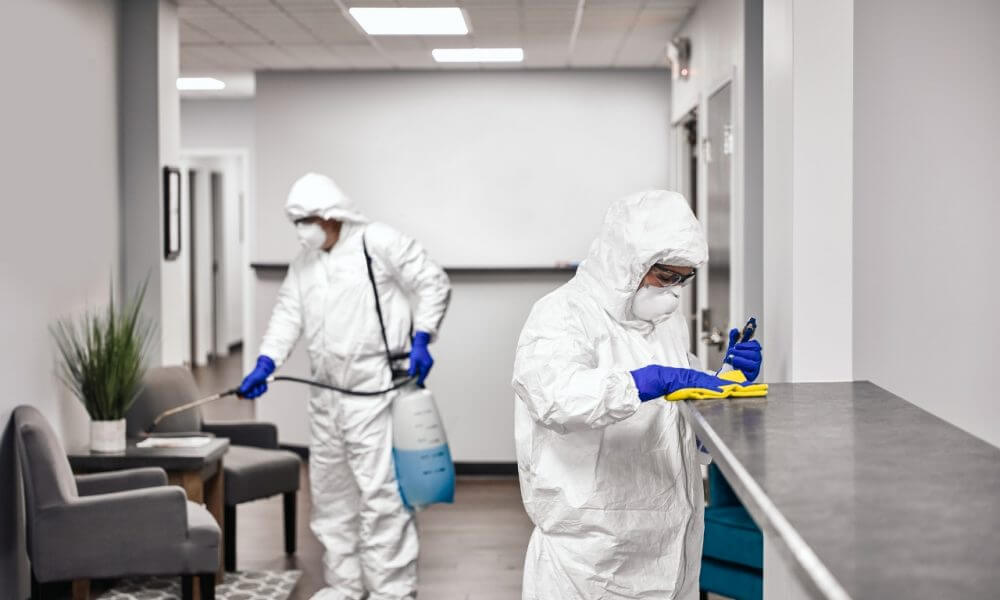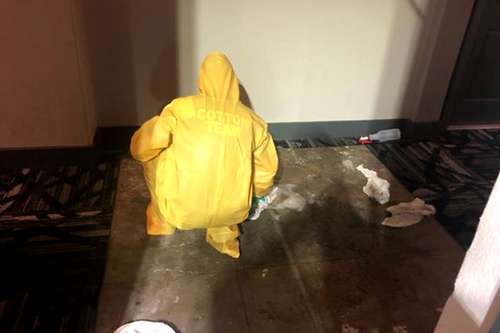Professional Blood Cleanup: Making Sure Safe and Thorough Purification
Professional Blood Cleanup: Making Sure Safe and Thorough Purification
Blog Article
Specialist Biohazard Cleansing and Decontamination for Blood, Bodily Fluids, and Hazardous Products
In the realm of biohazard cleansing and decontamination for blood, bodily fluids, and unsafe materials, accuracy and experience are extremely important. The possible wellness threats related to exposure to biohazards highlight the essential need for careful handling and detailed cleaning. Specialized training equips professionals with the expertise and abilities necessary to deal with these harmful scenarios successfully. Nonetheless, it is not simply concerning cleansing up; the relevance of employing correct decontamination strategies can not be overstated. As we browse the complex landscape of biohazard cleaning, comprehending the subtleties of policies, conformity, and the customized tools at play becomes important in ensuring a risk-free and detailed purification process.
Health And Wellness Dangers of Biohazard Direct Exposure
Direct exposure to biohazards poses substantial wellness risks that can lead to extreme effects for neighborhoods and individuals alike. Biohazards encompass a wide variety of biological compounds, including blood, bodily fluids, mold, bacteria, infections, and other potentially contagious products. When individuals come into contact with these biohazards, whether with accidents, improper handling, or environmental exposure, they deal with the risk of having severe diseases or conditions.
Among the primary health and wellness risks connected with biohazard direct exposure is the transmission of transmittable diseases. Bloodborne pathogens such as HIV, hepatitis B and C, and various germs can be existing in biohazardous materials, positioning a direct hazard to human wellness. Inhaling airborne biohazards like mold and mildew spores or entering into call with polluted surface areas can also cause respiratory system concerns, allergies, and other unfavorable health impacts.
Furthermore, biohazard exposure can have long-lasting health and wellness effects, with some conditions materializing years after the first get in touch with (Blood Cleanup). Consequently, it is critical to focus on appropriate biohazard cleansing and purification to alleviate these health and wellness risks and make certain the safety and security of areas and individuals

Specialized Educating for Biohazard Cleaning
When it involves taking care of biohazard cleanup effectively and securely, specialized training plays a basic function in making certain correct purification procedures are followed. Biohazard clean-up needs specific knowledge and skills to successfully minimize dangers associated with bloodborne microorganisms, physical fluids, and harmful products. Specialists educated in biohazard clean-up go through strenuous direction on how to safely manage, remove, and deal with biohazardous products to avoid contamination and exposure.
Specialized training for biohazard cleanup covers a variety of necessary topics, consisting of appropriate personal safety tools (PPE) use, bloodborne virus recognition, decontamination methods, and contaminated materials disposal procedures. People learnt biohazard cleanup are equipped with the necessary know-how to analyze contamination levels, determine possible threats, and execute ideal cleaning procedures in compliance with regulative criteria.
Continuous training and education are critical in the area of biohazard cleaning to stay upgraded on the most up to date purification technologies, safety and security procedures, and guidelines. By spending in specialized training, biohazard cleanup professionals can properly react to emergency situation cleanup situations and protect both public health and wellness and the setting.
Value of Proper Decontamination Methods
Making use of appropriate purification techniques is vital in biohazard cleaning to successfully remove dangerous products and minimize wellness risks. Efficient purification not just makes certain the removal of noticeable traces of blood, physical fluids, and other biohazards but additionally targets invisible virus that may posture major health and wellness risks if not appropriately eradicated. By following strict purification methods, educated specialists can dramatically decrease the risk of exposure to dangerous bacteria, infections, and microorganisms that might cause diseases or infections.
Appropriate purification methods include making use of specific equipment and anti-bacterials that are specifically made to counteract biohazards effectively. Comprehensive cleansing and disinfection of polluted areas are important to protect against the spread of pathogens and make certain a secure environment for passengers. Additionally, the correct disposal of biohazardous waste complying with purification treatments is vital in protecting against contamination of other surface areas or individuals.

Tools and Devices for Safe Cleaning
When dealing with blood, physical liquids, or harmful products, biohazard cleaning professionals rely on specialized equipment to lessen direct exposure threats and extensively sanitize the afflicted location. Furthermore, biohazard cleaning packages containing anti-bacterials, absorbing materials, and biohazard bags are used to securely dispose and consist of of contaminated things.
Advanced cleaning devices like hospital-grade disinfectants, HEPA-filtered vacuums, and misting devices are used to sanitize surfaces and eliminate biohazards successfully. Specialized devices such as sharps containers and biohazard garbage disposal bins are utilized to safely manage sharp things and biohazardous waste materials. By utilizing the ideal tools and tools, biohazard cleaning professionals can guarantee a thorough cleanup procedure that prioritizes safety and security and lessens health and wellness threats for both workers and occupants of the afflicted room.
Laws and Compliance in Biohazard Cleaning
Proper adherence to guidelines and compliance requirements is vital in biohazard cleansing to guarantee the safety and security of both employees and the environment. Federal government companies such as OSHA (Occupational Security and Wellness Management) and the EPA (Environmental Protection Firm) have established particular standards for biohazard cleaning procedures to reduce health and wellness threats and environmental contamination. These laws cover a series of aspects consisting of the handling, transportation, and disposal of biohazardous materials, in addition to the essential training and safety devices required for workers associated with the clean-up procedure.
Biohazard cleaning firms need to stay current with these regulations to assure that their operations meet the called for safety and security criteria. Failure to follow these policies can cause serious effects, consisting of penalties, lawful activity, and threatening the health of people and the setting. By following stringent laws and compliance actions, biohazard cleansing companies can efficiently alleviate dangers and guarantee a comprehensive and risk-free cleanup process for all parties entailed.
Final Thought
To conclude, biohazard cleansing and purification need specific training, appropriate methods, and adherence to regulations. Exposure to blood, bodily fluids, and harmful products postures significant wellness risks, making it essential to utilize the best tools and tools for secure cleanup. By complying with rigorous procedures and standards, professionals can properly mitigate the risks associated with biohazard exposure and guarantee the safety of both themselves and others.
As we browse the detailed landscape of biohazard clean-up, understanding the nuances of regulations, compliance, and the specific equipment at play ends up being critical in making certain a comprehensive and secure purification process. (Blood Cleanup)
When it comes to taking care of biohazard clean-up efficiently and securely, specialized training plays a fundamental duty in making certain appropriate decontamination treatments are followed.Using proper purification strategies is crucial in biohazard clean-up to effectively remove dangerous materials and decrease health dangers. In addition, biohazard cleaning kits homicide and suicide cleanup having disinfectants, absorptive products, and biohazard bags are used to securely get rid of and include of polluted things.
Government companies such as OSHA (Occupational Safety And Security and Health And Wellness Management) and the EPA (Environmental Defense Agency) have developed specific guidelines for biohazard clean-up treatments to minimize health and wellness dangers and ecological contamination.
Report this page